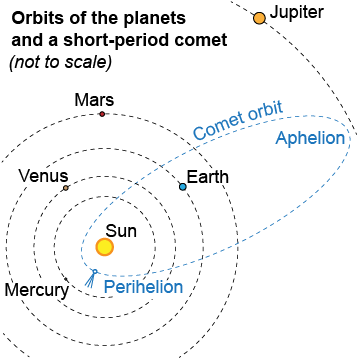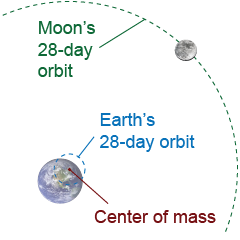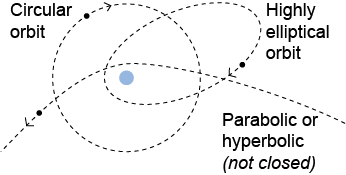|
A satellite is a natural or technological object gravitationally bound to a larger object, such as the Moon is bound to the Earth. The planets of the Solar System are technically satellites of the Sun. Gravity provides the centripetal force that bends the path of a satellite into an orbit. An orbit is a closed path, such as a circle, which the satellite repeats. Artificial satellites in orbit around Earth include the Hubble Space Telescope, the International Space Station, and hundreds of global positioning and communications satellites. 
 |
Why do astronauts in orbit around the Earth feel weightless? This is not because there is no gravity in space! It is because the spacecraft and the astronauts inside it undergo the same centripetal acceleration due to Earth’s gravity. Since both the spacecraft and the astronauts are “falling” in the same way, the floor provides no support force (normal force) to the astronauts. It is this lack of normal force that results in the apparent weightlessness. 
|
 Mathematically, orbits are ellipses; a circle is a type of ellipse in which all points are equally far from one center. Most of the planets, including Earth, orbit the Sun in nearly perfect circles. A satellite in a circular orbit moves with constant speed. Comets by comparison orbit the Sun in highly elliptical orbits. Comets move fastest at perihelion, when closest to the Sun and slowest at aphelion, when farthest from the Sun. Comets may come closer to the Sun than Mercury at perihelion and be farther than Neptune at aphelion.
Mathematically, orbits are ellipses; a circle is a type of ellipse in which all points are equally far from one center. Most of the planets, including Earth, orbit the Sun in nearly perfect circles. A satellite in a circular orbit moves with constant speed. Comets by comparison orbit the Sun in highly elliptical orbits. Comets move fastest at perihelion, when closest to the Sun and slowest at aphelion, when farthest from the Sun. Comets may come closer to the Sun than Mercury at perihelion and be farther than Neptune at aphelion. 
|
 The gravitational force that attracts the Moon to the Earth creates an equal and opposite reaction force that attracts the Earth to the Moon. The Earth and Moon both orbit the center of mass of the Earth–Moon system. In fact, part of the definition of a planet is that the center of mass of the system including the planet and all its moons be within the main planet. The Earth–Moon center of mass is about 2/3 of the way to Earth’s surface on the Moon-ward side.
The gravitational force that attracts the Moon to the Earth creates an equal and opposite reaction force that attracts the Earth to the Moon. The Earth and Moon both orbit the center of mass of the Earth–Moon system. In fact, part of the definition of a planet is that the center of mass of the system including the planet and all its moons be within the main planet. The Earth–Moon center of mass is about 2/3 of the way to Earth’s surface on the Moon-ward side. 
|
Not all objects moving in a gravitational field go into orbit! The path taken by an object depends on the ratio of its tangential velocity to its radial velocity. If the tangential velocity is too high, the acceleration of gravity is not enough to bend the object’s path into a closed orbit. The object moves along a hyperbolic path that does not return. If the tangential component of velocity is too low, the object’s trajectory makes it crash into the planet. 
|

 |
 A moving object approaching a planet may go into orbit, collide, or fly back into space. The outcome depends on the object’s velocity vector compared to the strength of the gravitational force.
A moving object approaching a planet may go into orbit, collide, or fly back into space. The outcome depends on the object’s velocity vector compared to the strength of the gravitational force.
The velocity of an object can be broken down into two components: radial and tangential. An orbit results when the centripetal force of gravity is enough to create a large enough centripetal acceleration to bend the tangential motion into a closed path. 
|

